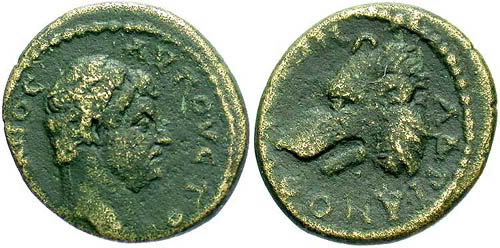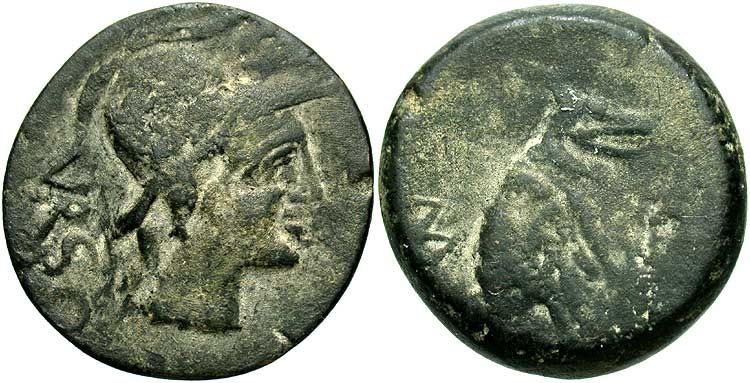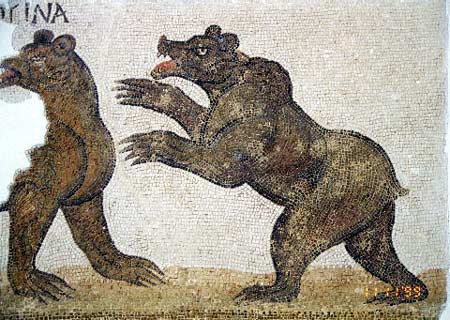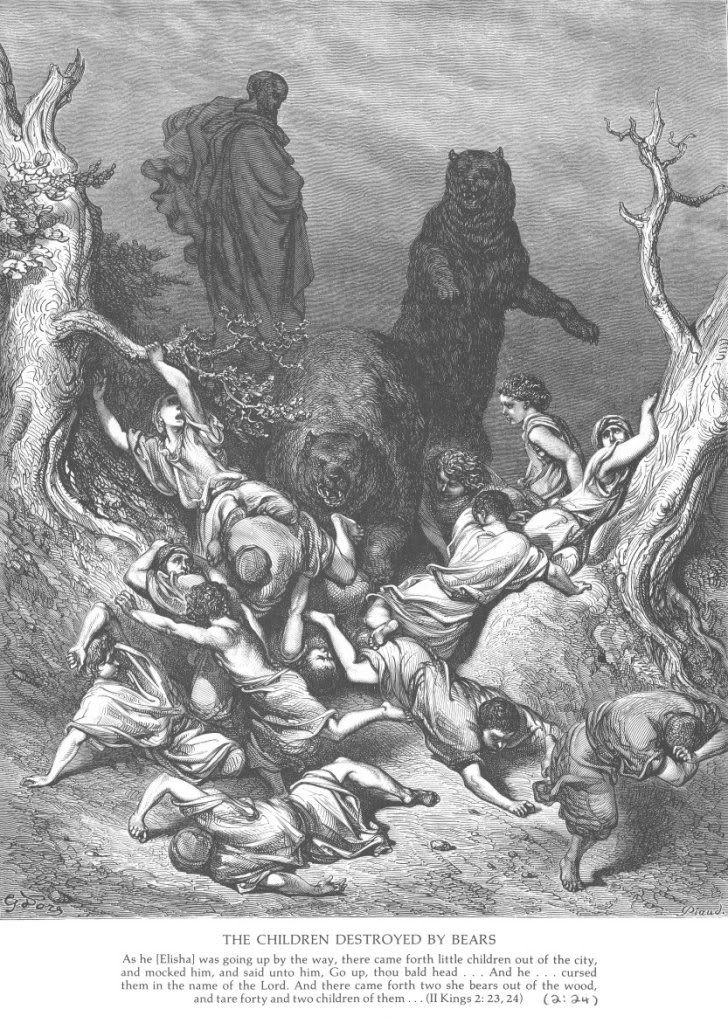|
|
Post by grrraaahhh on Nov 23, 2010 6:58:16 GMT -9
COINS Coin of the she-bear killed by Hadrian in his famous hunt. Afterward, at the same kill site, Hadrain founds the city named Hadrian's Hunt.  Bear coin from Mantinea, Arcadia: 490s-470s B.C.  Bear coin from Spain: 150-100 B.C.
|
|
|
|
Post by grrraaahhh on Dec 21, 2010 19:18:01 GMT -9
URSUS MAJOR
|
|
|
|
Post by grrraaahhh on Mar 10, 2011 5:50:17 GMT -9
 Above: Mosaic of Bear & Bull Colosseum battle in Ancient Rome. |
|
|
|
Post by grrraaahhh on Mar 10, 2011 5:56:16 GMT -9
 Above: Ancient mosaic of the extinct Atlas Brown Bear. |
|
|
|
Post by grrraaahhh on Mar 10, 2011 5:58:14 GMT -9
 Celtic bear-goddess Artio. Bronze artifact c. A.D. 200 from Musée de St. Germaine en Laye, published in Campbell’s, Historical Atlas of World Mythology, v 1 part 2, p. 155. |
|
|
|
Post by grrraaahhh on Mar 10, 2011 9:06:42 GMT -9
|
|
|
|
Post by grrraaahhh on Mar 22, 2011 12:52:05 GMT -9
 Gustave Dore. |
|
|
|
Post by grrraaahhh on May 7, 2011 7:43:15 GMT -9
ChinaThe totem of the ancestorThe three jade bears excavated from the Yin Xu Fuhao Tomb of An Yang of He Nan province are the earliest examples bear artwork known today. At the end of July of 2010, one of the three jade bears was exhibited at the Capital Museum in an exhibit about archaeological work in China. The jade bear vividly depicted the image of a bear, setting an example for the later works of the the Han Dynasty. There is a long history behind the use of the bear as a totem. In the Shang Dynasty, people used the bird as a totem. After that, the Shu Emperor of the Shang Dynasty made the silkworm his totem. In ancient times, people of the eastern tribes and the Shennong ethnic minorities used dragon as their totem. When the Yan Emperor and Yellow Emperor began to govern the country, they made great contributions to the integration of the ethnic groups. What is more, the Yellow Emperor built his capital at Xinzheng, where had some bears. Therefore, he was also called “You Xiongshi,” meaning “Bear Emperor.” It was said that the Chinese myth of “Shan Hai ching,” which was deeply loved and praised by Lu Xun, a famous Chinese writer, was written for the Chu people of the Warring States Period. The story begins with a high mountain, called the Bear Mountain. There were many caves in the mountain, where bears lived and the immortals always went there to play with bears. In the summer, the doors of the caves were open, while in winter, the doors of the caves were closed. If the doors of the caves were open in the winter, turmoil and disaster would occur. Therefore, there was some relation between the bear and divinity that could decide the wealth or woe of the common people. Although it was a myth, people in ancient times believed it, and the bear totem commanded great respect at that time. It was recorded in the work “Zuo Zhuan” that the Chu Cheng king ate a bear’s paw before he killed himself after he lost a battle. It was also once believed that the oldest ancestor of the Xia ethnic group became a bear after he died. It is therefore clear that people in ancient times showed great favor and respect to the bear. The people of the the Han Dynasty also respected the bearThe people of the the Han Dynasty continued the folk customs of the Chu dynasty. Therefore, it is certain that the people of the the Han Dynasty loved and respected the bear. Many cultural relics of the the Han Dynasty excavated from tombs like Zeng Hongji and Ma Wangdui involved images of bears. Most of the artistic works delineated a bear’s shape extremely vividly and nicely. www.chinaculture.org/chineseway/2011-01/28/content_405029.htm
|
|
|
|
Post by grrraaahhh on May 7, 2011 7:49:16 GMT -9
ChinaThe totem of the ancestorThe three jade bears excavated from the Yin Xu Fuhao Tomb of An Yang of He Nan province are the earliest examples bear artwork known today. At the end of July of 2010, one of the three jade bears was exhibited at the Capital Museum in an exhibit about archaeological work in China. The jade bear vividly depicted the image of a bear, setting an example for the later works of the the Han Dynasty. There is a long history behind the use of the bear as a totem. In the Shang Dynasty, people used the bird as a totem. After that, the Shu Emperor of the Shang Dynasty made the silkworm his totem. In ancient times, people of the eastern tribes and the Shennong ethnic minorities used dragon as their totem. When the Yan Emperor and Yellow Emperor began to govern the country, they made great contributions to the integration of the ethnic groups. What is more, the Yellow Emperor built his capital at Xinzheng, where had some bears. Therefore, he was also called “You Xiongshi,” meaning “Bear Emperor.” It was said that the Chinese myth of “Shan Hai ching,” which was deeply loved and praised by Lu Xun, a famous Chinese writer, was written for the Chu people of the Warring States Period. The story begins with a high mountain, called the Bear Mountain. There were many caves in the mountain, where bears lived and the immortals always went there to play with bears. In the summer, the doors of the caves were open, while in winter, the doors of the caves were closed. If the doors of the caves were open in the winter, turmoil and disaster would occur. Therefore, there was some relation between the bear and divinity that could decide the wealth or woe of the common people. Although it was a myth, people in ancient times believed it, and the bear totem commanded great respect at that time. It was recorded in the work “Zuo Zhuan” that the Chu Cheng king ate a bear’s paw before he killed himself after he lost a battle. It was also once believed that the oldest ancestor of the Xia ethnic group became a bear after he died. It is therefore clear that people in ancient times showed great favor and respect to the bear. The people of the the Han Dynasty also respected the bearThe people of the the Han Dynasty continued the folk customs of the Chu dynasty. Therefore, it is certain that the people of the the Han Dynasty loved and respected the bear. Many cultural relics of the the Han Dynasty excavated from tombs like Zeng Hongji and Ma Wangdui involved images of bears. Most of the artistic works delineated a bear’s shape extremely vividly and nicely. www.chinaculture.org/chineseway/2011-01/28/content_405029.htm  Grizzly bear totem in CN Park, Prince Rupert, British Columbia, 1932. www.collectionscanada.gc.ca/stories/020020-6000-e.html |
|
|
|
Post by grrraaahhh on May 7, 2011 8:41:54 GMT -9
China (continued)ChinaThe totem of the ancestorThe three jade bears excavated from the Yin Xu Fuhao Tomb of An Yang of He Nan province are the earliest examples bear artwork known today. At the end of July of 2010, one of the three jade bears was exhibited at the Capital Museum in an exhibit about archaeological work in China. The jade bear vividly depicted the image of a bear, setting an example for the later works of the the Han Dynasty. There is a long history behind the use of the bear as a totem. In the Shang Dynasty, people used the bird as a totem. After that, the Shu Emperor of the Shang Dynasty made the silkworm his totem. In ancient times, people of the eastern tribes and the Shennong ethnic minorities used dragon as their totem. When the Yan Emperor and Yellow Emperor began to govern the country, they made great contributions to the integration of the ethnic groups. What is more, the Yellow Emperor built his capital at Xinzheng, where had some bears. Therefore, he was also called “You Xiongshi,” meaning “Bear Emperor.” It was said that the Chinese myth of “Shan Hai ching,” which was deeply loved and praised by Lu Xun, a famous Chinese writer, was written for the Chu people of the Warring States Period. The story begins with a high mountain, called the Bear Mountain. There were many caves in the mountain, where bears lived and the immortals always went there to play with bears. In the summer, the doors of the caves were open, while in winter, the doors of the caves were closed. If the doors of the caves were open in the winter, turmoil and disaster would occur. Therefore, there was some relation between the bear and divinity that could decide the wealth or woe of the common people. Although it was a myth, people in ancient times believed it, and the bear totem commanded great respect at that time. It was recorded in the work “Zuo Zhuan” that the Chu Cheng king ate a bear’s paw before he killed himself after he lost a battle. It was also once believed that the oldest ancestor of the Xia ethnic group became a bear after he died. It is therefore clear that people in ancient times showed great favor and respect to the bear. The people of the the Han Dynasty also respected the bearThe people of the the Han Dynasty continued the folk customs of the Chu dynasty. Therefore, it is certain that the people of the the Han Dynasty loved and respected the bear. Many cultural relics of the the Han Dynasty excavated from tombs like Zeng Hongji and Ma Wangdui involved images of bears. Most of the artistic works delineated a bear’s shape extremely vividly and nicely. www.chinaculture.org/chineseway/2011-01/28/content_405029.htm  Grizzly bear totem in CN Park, Prince Rupert, British Columbia, 1932. www.collectionscanada.gc.ca/stories/020020-6000-e.html
|
|
|
|
Post by grrraaahhh on Jun 21, 2011 11:07:56 GMT -9
BODYGUARD BEARS
"Roman Emperor Valentinian I (ad 321 to 375; became emperor in ad 364) used two quite large brown bears in the capacity of "bodyguards," chaining them nightly in front of his sleeping chamber. His bodyguards were apparently effective at their home post, as the emperor died during a battle in Moravia."
Brown, G. 1993. The Great Bear Almanac. New York Lyons & Burford.
|
|
bottledhammer
New Member
 There's much more to She the Bear than a damn tree...
There's much more to She the Bear than a damn tree...
Posts: 1 
|
Post by bottledhammer on Aug 2, 2011 17:16:11 GMT -9
There is more to the bear than that - I've been researching it for some years now, and there is metallurgy, hunting, ancestral, magical, and abundance ties to the bear. If you want to know more, let me know.
|
|
|
|
Post by grrraaahhh on Aug 2, 2011 18:17:02 GMT -9
There is more to the bear than that - I've been researching it for some years now, and there is metallurgy, hunting, ancestral, magical, and abundance ties to the bear. If you want to know more, let me know. Welcome. I think you are referencing the Roman Emperor Valentinian I bear? In any event, the answer is yes...feel free to contribute either in this thread or with the start of another thread. Beyond providing data on bears, the main goal of the bear forum is to attract other people who can contribute and help pool data on bears in every form including Bears in Antiquity. |
|
|
|
Post by sarus on Sept 29, 2011 22:24:20 GMT -9
|
|
|
|
Post by grrraaahhh on Sept 30, 2011 5:52:31 GMT -9
WELCOME! Nice find. I've enjoyed all of your posts. Keep them coming. Cheers |
|